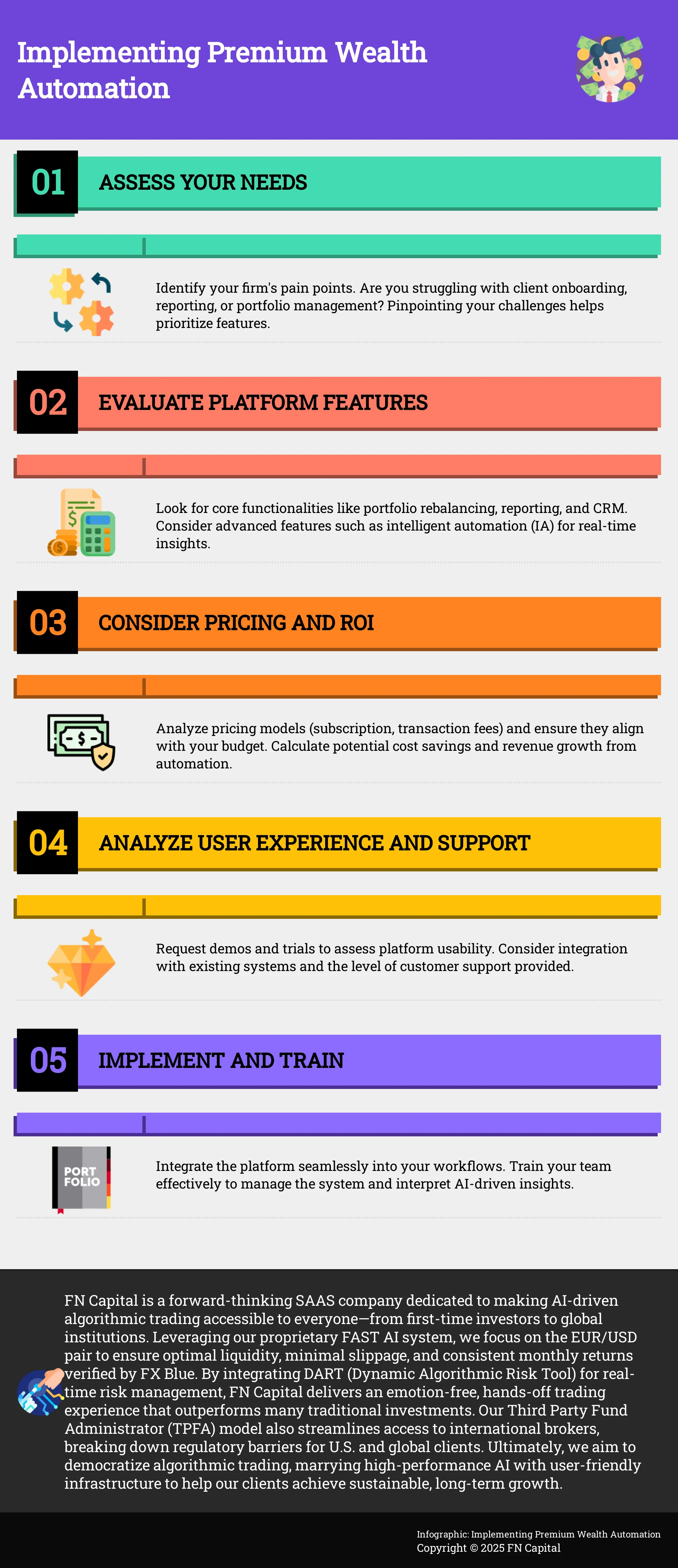In the competitive landscape of wealth management, differentiation is key. Offering a premium client experience is no longer a luxury—it’s an expectation. Premium wealth automation empowers you to exceed those expectations by providing personalized insights, proactive portfolio management, and seamless digital interactions. This approach leverages cutting-edge technology to streamline your workflow, enhance client engagement, and ultimately, drive growth. This comprehensive guide will explore the essential features, benefits, and considerations for implementing premium wealth automation in your practice.
Key Takeaways
- Premium wealth automation boosts advisor productivity: Streamlining time-consuming tasks allows advisors to prioritize personalized financial guidance and deeper client relationships, driving growth and enhancing service quality.
- Clients gain more control and convenience: Personalized insights, 24/7 access to information, and streamlined processes empower clients to actively manage their finances and build stronger connections with their advisors.
- Successful implementation requires a strategic approach: Firms must carefully assess their needs and resources, prioritize seamless integration, and invest in team training to fully leverage the benefits of premium wealth automation.
What is Premium Wealth Automation?
Premium wealth automation takes the core concepts of automation in wealth management and elevates them. It’s about more than just basic task automation; it’s about using technology to create a truly premium experience for both advisors and their clients. Think streamlined workflows, personalized insights, and proactive portfolio management—all powered by cutting-edge technology.
Definition and Core Components
Intelligent automation (IA) sits at the heart of premium wealth automation. It combines the power of robotic process automation (RPA), business process management (BPM), and artificial intelligence (AI) to not only automate those everyday, time-consuming tasks, but also to unlock real-time data insights that empower wealth and asset managers to make better decisions. This means advisors can spend less time on administrative work and more time focusing on what truly matters: building relationships and helping clients achieve their financial goals. These platforms prioritize the security of sensitive financial data through robust measures like encryption and access controls.
How It Works
In practice, premium wealth automation leverages AI, machine learning, and robotic process automation (RPA) to handle repetitive tasks and process data with incredible efficiency. Think of tasks like client onboarding, compliance reporting, and even some aspects of portfolio management—all handled seamlessly in the background. This frees up advisors to focus on higher-value activities like providing personalized financial advice and building deeper client relationships. As machines take over these routine tasks, advisors can focus on more creative and strategic work. By processing vast amounts of financial data, AI models can generate actionable insights, empowering both advisors and investors to make more informed decisions.
Key Benefits of Premium Wealth Automation
Premium wealth automation offers numerous advantages for advisors seeking to optimize their practice and enhance client relationships. Let’s explore some of the core benefits:
Increase Efficiency and Scalability
As a financial advisor, your time is your most valuable asset. Premium wealth automation solutions empower you to streamline operations and boost productivity by automating repetitive tasks like client onboarding, report generation, and trade execution. Offloading these routine processes frees you to focus on higher-value activities, such as providing personalized financial advice and building stronger client relationships. This increased efficiency naturally improves scalability. By automating key workflows, you can manage a larger client base without sacrificing service quality, ultimately growing your business. Intelligent automation combines the power of robotic process automation, business process management, and artificial intelligence to handle these routine tasks and offer real-time data insights to support your decision-making. This allows you to focus on what truly matters: helping your clients achieve their financial goals.
Enhance Client Experience
In today’s digital world, clients expect seamless and personalized experiences. Premium wealth automation helps you deliver. Integrating customer-facing technology with self-service forms automation streamlines processes like account updates and information requests, empowering clients to manage their finances more efficiently. These platforms often include features like secure messaging and video consultations, providing convenient access to you and fostering stronger connections. Whether your clients are seasoned investors or just starting out, these tools enhance communication and build trust.
Improve Regulatory Compliance
Staying compliant with evolving regulations is crucial. Premium wealth automation platforms often incorporate features designed to simplify compliance with industry rules like FINRA, SEC, and GDPR. Automating processes reduces the risk of human error and ensures consistent adherence to regulatory requirements. This protects your business from potential penalties and builds client confidence in your professionalism and commitment to ethical practices.
Make Data-Driven Decisions
Premium wealth automation platforms provide robust data and analytics capabilities. By leveraging AI and machine learning, these platforms can analyze large datasets to identify trends, generate insights, and inform your investment strategies. This data-driven approach empowers you to make more informed decisions, optimize portfolios, and deliver better results for your clients. Automating mechanical jobs with data frees up your IT team to focus on understanding new technologies, cybersecurity threats, and system integrations, further strengthening your practice.
Essential Features
Premium wealth automation platforms offer a suite of tools designed to streamline your workflow and enhance client relationships. Here’s a closer look at some essential features:
Customizable Reporting and Analytics
Clear, concise reporting is crucial for communicating with clients and demonstrating your value. Top-tier platforms provide highly customizable reporting, allowing you to tailor information to individual client needs. This level of personalization is especially valuable for high-net-worth individuals who expect detailed insights into their portfolio performance. Praemium, for example, is recognized for its robust reporting capabilities, consistently ranking high in industry benchmarks for data and reporting features. This focus allows advisors to efficiently deliver the precise information clients need, when they need it.
Portfolio Rebalancing and Optimization
Effective portfolio management requires constant oversight and adjustment. Premium wealth automation solutions automate the time-consuming process of portfolio rebalancing, ensuring adherence to target asset allocations and minimizing risk. These platforms leverage intelligent automation (IA), combining elements of robotic process automation (RPA), business process management (BPM), and artificial intelligence (AI). This sophisticated approach not only automates routine tasks but also provides real-time data insights, empowering you to make informed optimization decisions. This frees up your time to focus on higher-level strategic planning and client interaction.
Risk Assessment and Management Tools
Managing risk is paramount in the financial world. Premium platforms offer advanced risk assessment and management tools that go beyond basic metrics. While AI and machine learning can significantly enhance efficiency in identifying and mitigating potential risks, it’s important to maintain a balanced approach. Over-reliance on AI can amplify biases or create unexpected volatility. Look for platforms that prioritize transparency and offer robust governance features, allowing for human oversight and control. Features like stress-testing and auditable systems are essential for ensuring responsible AI integration. This balanced approach, combining AI efficiency with human expertise, is key to effective risk management.
System Integrations
Seamless data flow is critical for efficient wealth management. Your platform should integrate smoothly with existing systems, including custodians, banks, and alternative investment platforms. This integration simplifies data aggregation, reconciliation, and presentation, eliminating manual data entry and reducing the risk of errors. Efficient data management is the foundation of informed decision-making and personalized client service. By streamlining these processes, you can focus on building stronger client relationships and achieving their financial goals.
Top Premium Wealth Automation Platforms
Finding the right wealth automation platform can feel overwhelming. So many options exist, each with its own strengths and weaknesses. To simplify your search, we’ve highlighted some leading platforms known for their robust features and focus on streamlining wealth management.
Praemium
Praemium offers a comprehensive Managed Accounts platform designed for efficiency. Their automated rebalancing engine minimizes drift between investor portfolios and model portfolios, ensuring your clients’ investments stay aligned with their goals. This frees you to focus on higher-value tasks. Praemium is a solid option for advisors looking to improve accuracy and reduce operational costs.
Wealthfront
Wealthfront is known for its automated investment services, leveraging advanced algorithms to manage portfolios. Features like tax-loss harvesting and financial planning tools make it a valuable platform for a range of investors. By automating routine tasks, Wealthfront allows advisors to dedicate more time to strategic planning and client relationships.
Betterment
A pioneer in the robo-advisory space, Betterment provides automated investment management with a focus on goal-based investing. Their algorithms create personalized investment strategies, so you can offer tailored client solutions. Automatic rebalancing and tax optimization features further enhance efficiency, allowing you to scale your services.
FN Capital’s FAST AI
FN Capital’s FAST AI platform uses artificial intelligence to optimize investment strategies and enhance decision-making. FAST AI automates data analysis and portfolio management, allowing advisors to prioritize client relationships and strategic initiatives. This AI-driven approach can significantly improve service delivery and operational efficiency.
AdvisorEngine
AdvisorEngine offers a comprehensive wealth management platform that integrates client relationship management (CRM), portfolio management, and financial planning tools. Its automation capabilities streamline workflows, enabling you to manage client accounts more efficiently and deliver personalized advice at scale. The platform’s user-friendly interface also benefits clients while reducing administrative burdens.
Orion Advisor Solutions
Orion Advisor Solutions provides a robust suite of tools to automate various aspects of wealth management, from portfolio management and reporting to client communications. Their integrated solutions simplify complex processes, improving advisor efficiency and freeing up your time. Orion’s technology-driven approach empowers advisors to deliver high-quality service without getting bogged down by administrative work.
Choosing the Right Solution
Finding the perfect wealth automation platform can feel overwhelming. With so many options, how do you select the one that truly aligns with your firm’s goals and elevates your services? This section breaks down the key considerations to guide your selection process.

Assess Your Needs
Before you start researching specific platforms, take a step back and honestly assess your firm’s needs. Wealth management firms face increasing demands for efficiency, personalization, compliance, and digital engineering. What are your current pain points? Are you struggling with client onboarding, reporting, or portfolio management? Identifying your biggest challenges will help you prioritize features and narrow your options. For example, if compliance is a major concern, look for platforms with robust regulatory features. If you’re looking to scale your business, prioritize solutions that offer scalability and automation. Understanding your needs is the first step toward finding the right solution. Learn more about the challenges faced by wealth management firms.
Evaluate Platform Features
Once you understand your needs, it’s time to evaluate the features of different platforms. Look for solutions that offer the core functionalities you require, such as portfolio rebalancing, reporting, and client relationship management (CRM). Consider advanced features like intelligent automation (IA), which combines robotic process automation (RPA), business process management (BPM), and artificial intelligence (AI) to automate routine tasks and offer real-time data insights. This level of automation can free up your advisors to focus on higher-value activities, such as financial planning and client interaction. Don’t get caught up in flashy features you won’t use. Focus on the functionalities that will directly address your firm’s needs and improve your overall efficiency.
Consider Pricing and ROI
Pricing is always a critical factor when choosing new technology. Wealth automation platforms typically offer various pricing models, such as subscription-based fees, transaction fees, or a combination of both. Carefully analyze the pricing structure and ensure it aligns with your budget and projected ROI. Remember, the cheapest option isn’t always the best value. Consider the long-term benefits of investing in a premium solution that can significantly enhance your productivity and client experience. Offloading tedious recurring processes frees up time for finance professionals to concentrate on areas where critical and strategic thinking are imperative. Learn how automation can impact your bottom line. Calculate the potential cost savings and revenue growth that automation can bring.
Analyze User Experience and Support
Finally, don’t overlook user experience and support. A wealth automation platform should be intuitive and easy to use for both your advisors and your clients. Request demos and trials to get a feel for the platform’s interface and navigation. Consider how the platform integrates with your existing systems and workflows. Seamless integration can minimize disruption and ensure a smooth transition. Also, inquire about the level of customer support provided. Responsive and knowledgeable support can be invaluable when you encounter technical issues or have questions. A positive user experience contributes to increased advisor satisfaction and client engagement.
Implementing Premium Wealth Automation
Successfully implementing premium wealth automation requires a strategic approach. It’s not just about choosing the right platform; it’s about integrating it effectively into your existing workflows, training your team, and proactively addressing potential challenges. This section outlines the key steps to ensure a smooth and successful implementation.
Integrate Seamlessly
A core component of successful wealth automation is seamless integration. Connecting your customer-facing technology with automated, self-service forms allows you to efficiently serve a wider range of clients. Think of clients who prefer a high-touch, personalized approach, alongside those who value the speed and convenience of self-service transactions. A well-integrated system creates a cohesive client experience for everyone. This also includes leveraging intelligent automation (IA), which combines the power of robotic process automation (RPA), business process management (BPM), and artificial intelligence (AI). This powerful combination automates routine tasks and provides the real-time data insights needed to support your wealth management strategies.
Train Your Team Effectively
Even with the best automation platform, your team remains essential. They’re the ones who ensure the automation logic stays updated with current business needs and handle any necessary bug-fixing. Freeing them from manual tasks allows them to develop a deeper understanding of new technologies and potential cyber threats. Invest in training that empowers your team to not just manage the automation system, but also to critically challenge its outputs and ensure a balanced approach.
Overcome Challenges
Implementing any new technology comes with challenges. In wealth management, these often include increasing demands for efficiency, personalization, compliance, and digital transformation. One common pitfall is data integration failures, which can derail even the best automation strategies. Another hurdle is the limitations of legacy systems. These older systems often lack the flexibility and capacity to support the variable computing requirements, data processing, and real-time analysis that AI requires. Addressing these challenges head-on, through careful planning and investment in the right infrastructure, is crucial for successful implementation.
The Future of Wealth Automation
We’re on the cusp of a significant shift in how wealth is managed, thanks to rapid advancements in AI and automation. This isn’t just about automating tedious tasks—it’s about fundamentally reshaping the financial landscape. Let’s explore what the future holds.
Emerging Trends and Technologies
The integration of artificial intelligence (AI) with existing automation tools is creating what experts call intelligent automation (IA). This powerful combination goes beyond basic robotic process automation (RPA) by incorporating business process management (BPM) and real-time data analysis. Think of it as having a tireless digital assistant that not only handles routine tasks but also provides valuable insights to support wealth managers. This shift toward IA is poised to become the backbone of future wealth management platforms. Gartner predicts that by 2026, 90% of finance functions will incorporate at least one AI-enabled solution, and PwC estimates that AI-powered robo-advisors could manage nearly $6 trillion in assets by 2027. These figures highlight the accelerating pace of adoption and the enormous potential of AI in wealth management.
Impact on Wealth Management
This wave of automation will free up human advisors to focus on higher-value activities. As machines take over repetitive tasks, the future of finance promises more creative and strategic roles. The future demands a different skill set, emphasizing client interaction, complex problem-solving, and personalized financial planning. However, this transition also presents challenges. One key concern is ensuring that AI operates ethically and aligns with human values. Another is managing the ever-increasing volume and complexity of data. As Forbes points out, effectively leveraging AI-driven automation requires high-quality data and a clear understanding of how to extract tangible business value. Successfully navigating these challenges will be crucial for firms looking to thrive in the age of intelligent automation.
Is Premium Wealth Automation Right for You?
Deciding whether to implement premium wealth automation is a significant step. It requires careful consideration of your firm’s current capabilities, resources, and long-term goals. This section helps you determine if your firm is ready to embrace this technology.
Evaluate Your Automation Readiness
Wealth management firms face increasing demands for efficiency, personalization, and compliance. Ask yourself these key questions:
- Are you struggling to keep up with client demands? If you’re finding it difficult to scale your services while maintaining personalized attention, automation can help.
- Do you spend excessive time on repetitive tasks? Freeing up your team from tedious processes allows them to focus on higher-value activities like client interaction and strategic planning, as highlighted in this article on data and automation in finance.
- Is your technology infrastructure up-to-date? A modern, integrated system is crucial for successful automation. If your current systems are outdated or siloed, you may need to invest in upgrades before implementing premium wealth automation.
- Are your team members receptive to new technology? Automation requires a shift in mindset and workflow. Ensure your team is open to learning and adapting to new tools and processes.
Weigh the Pros and Cons
Like any technology, premium wealth automation has both advantages and disadvantages. Carefully consider these factors before making a decision:
Pros:
- Increased efficiency and scalability: Automate routine tasks, freeing up advisors to manage more clients and assets.
- Enhanced client experience: Provide personalized service and 24/7 access to information.
- Improved regulatory compliance: Reduce errors and ensure adherence to industry regulations.
- Data-driven insights: Leverage data analytics to make informed investment decisions.
- Focus on higher-value tasks: Automation allows financial professionals to focus on more creative and strategic work, as this article on wealth management automation explains.
Cons:
- Implementation costs: Investing in new software and training can be expensive.
- Integration challenges: Connecting new systems with existing infrastructure can be complex.
- Data security and privacy concerns: Protecting sensitive client data is paramount.
- Ethical considerations: Ensure the algorithms used align with human values and ethical codes, a key challenge highlighted in this Forbes article.
- Ongoing maintenance: Automation isn’t a one-time fix; it requires continuous monitoring and updates, as discussed in this Forbes article on automation myths.
By carefully evaluating your firm’s readiness and weighing the pros and cons, you can make an informed decision about whether premium wealth automation is the right solution for you.
Related Articles
- Secure Wealth Growth: Practical Steps for Building Wealth – FN Capital
- How High-Net-Worth Investors Benefit from Automated Cash Growth Algorithms – FN Capital
- Best AI Investing Strategies for High-Net-Worth – FN Capital
- Financial Autonomy Solutions: Transforming the World of Finance – FN Capital
- Empowered Wealth Management: A Financial Guide
Frequently Asked Questions
What exactly is premium wealth automation?
Premium wealth automation goes beyond simply automating individual tasks. It’s about creating a seamless, integrated experience that streamlines your entire wealth management process, from client onboarding to portfolio management. It leverages AI and machine learning to provide personalized insights and proactive service, allowing you to focus on building stronger client relationships.
How does premium wealth automation improve the client experience?
Clients benefit from increased efficiency, personalized service, and 24/7 access to their financial information. Features like secure messaging, video consultations, and self-service portals empower clients to manage their finances more effectively and stay connected with you.
What are the key features I should look for in a premium wealth automation platform?
Essential features include customizable reporting and analytics, automated portfolio rebalancing and optimization, advanced risk assessment tools, and seamless integration with existing systems. Look for platforms that offer intelligent automation capabilities, combining RPA, BPM, and AI to provide real-time insights and streamline your workflows.
How do I choose the right wealth automation solution for my firm?
Start by assessing your firm’s specific needs and challenges. Then, evaluate the features, pricing, and user experience of different platforms. Consider your technology infrastructure and your team’s readiness to adopt new tools. Request demos and trials to get a hands-on feel for the platform before making a decision.
What are the potential challenges of implementing wealth automation, and how can I overcome them?
Implementation costs, integration complexities, data security concerns, and ethical considerations around AI are all potential challenges. Careful planning, investment in robust technology, and ongoing training for your team are crucial for successful implementation and long-term success. Focus on building a strong data infrastructure and ensuring your team is prepared to manage and interpret the insights provided by AI.





